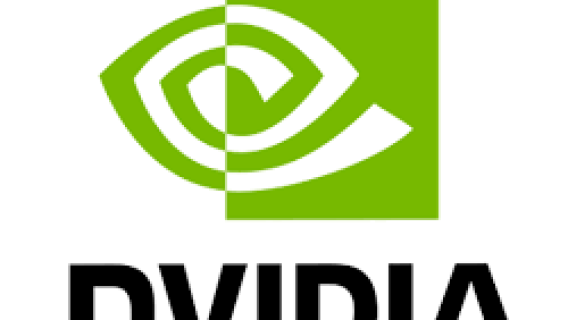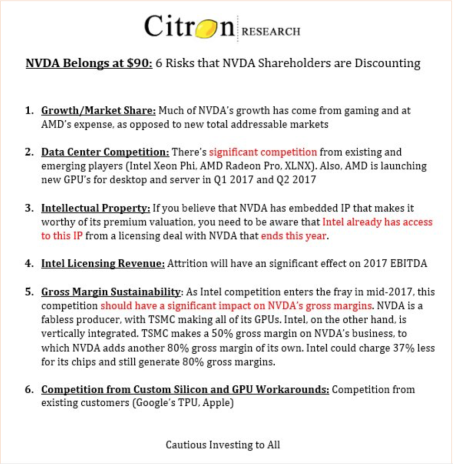At year-end, I always focus my attention on the action in stocks and sectors that have been strong or weak in the past year. That’s because when the calendar flips to the New Year, there’s often a move INTO the dogs of the previous year and OUT OF the winners. Two of the biggest winners of 2016 were Nvidia stock and Advanced Micro Devices stock, which are up a staggering 250% and 315%, respectively.
In mid-December, I received an email from a subscriber essentially asking, “When do we short Nvidia (NVDA)?”
My answer to the question is that if you want to short Nvidia stock, wait until the start of the new year, and use puts to get bearish exposure. Because of tax, ownership and marking issues, many traders will hold their big winners through the close of the year. Then, as the calendar flips to 2017, traders often take some of their gains.

Read Your Free Report Here.

Read Your Free Report Here.

Read Your Free Report Here.

Read Your Free Report Here.
That said, Nvidia stock took a big fall last Wednesday after short-seller Citron Research, which is best known for its bearish call on Valeant Pharmaceuticals (VRX), tweeted six reasons it believed NVDA was overpriced. Here was the tweet:
So if you like the bearish thesis that Citron highlighted and you want to short Nvidia stock (which I am not recommending), buying put options would be a good way to get bearish exposure.
A buyer of a put option gives the buyer the right to SELL 100 shares of the stock at a fixed price (strike price) before a specified date (expiration date).
For example, if you wanted to short NVDA, you could execute the following trade:
Buy 1 NVDA February 100 Put for $6.
Let me break down what the purchase of this put actually means.
If Nvidia stock falls below the put’s strike price (100), you could exercise your put, which would leave you short 100 shares of NVDA at 100. Or you could sell your put for a profit. (At Cabot Options Trader and Cabot Options Trader Pro, we rarely take delivery of the stock; instead, we typically sell out our calls/puts for a profit or loss.)
However, you do have to pay $6 for the put, which is actually $600 because each put equals 100 shares of stock. And if NVDA stock closes above 100 on February expiration, your put would expire worthless and you would lose the $600. However, the $600 is the most you can possibly lose on the position.
That said, I am NOT recommending shorting NVDA—or Advanced Micro Devices (AMD) either. In fact, Cabot Options Trader and Cabot Options Trader Pro subscribers currently hold a winning bullish position in AMD.
Let me describe our AMD position.
On November 16, I recommended to Cabot Options Trader subscribers a buy-write position in AMD. A buy write/covered call is an options strategy in which you buy the stock, and sell a call option against it. For every 100 shares of the stock that you buy, you can sell 1 call.
Here’s the trade alert that I sent to subscribers. The first line of the trade alert is the trade idea. Then I go into why we are executing the trade, exactly how to execute the trade, and the various scenarios if the stock goes up or down.
Buy-Write: Buy Advanced Micro Devices (AMD) Stock and Sell the January 7 Calls (exp. 1/20/2017) for a net price of $6.40 or less.
AMD has been a favorite of call buyers for months. And today, the action has been very strong including a buy of 8,700 April 10 Calls for $0.55. This is a very aggressive call buy, considering the stock is around 7.30 and also shows just how expensive calls are. Because of the bullish action, and the expensive volatility, I want to add a short volatility/bullish trade in AMD.
To execute this trade you need to:
Buy AMD Stock, and
Sell to Open the January 7 Calls.
For example, you could buy AMD stock for 7.45 and sell the January 7 Calls for 1.05.
The important component is that the net is equal to $6.40 or less.
The most you can make is $0.60, or a yield of 9.375% in two months’ time if AMD closes above 7 on January expiration.
Our breakeven is at 6.40.
The most you can lose is $640 per buy-write if AMD were to go to zero.
A potential yield of 9.375% in two months would be a solid base hit in the current market environment.
If you prefer to sell puts, selling the January 7 put for $0.60 is virtually the exact same trade.
The trade has worked extremely well as AMD is now trading $4.50 above the strike price of the call we sold. And unless the stock drops from 11.5 to 7 by January 20, Cabot Options Trader subscribers will collect our full 9.375% profit.


